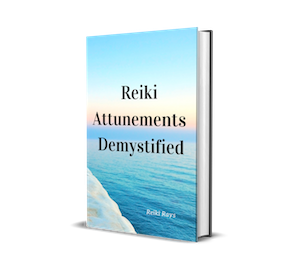Article by Isabella Dove, Reiki Master
Strictly from the perspective of teaching Reiki, attunements represent an invaluable moment if not a peak of energy in the class. Both from the RMT perspective – Reiki Master Teacher – and the student’s point of view, the attunements seem to carry special meanings. Does it mean that Reiki per se as pure energy would not have similar effects without attunements? Does it mean that protocols of attunements are standards and must be followed strictly to be effective? In this article I will explore a bit how an intuitive experience of intentionally wanting to stick to integrity and at the same time moving with shifting Earth energies resulted in feeling at peace with the choices made.
Each level of teaching has its own process of attunement. Explaining what an attunement is, how it works and why it is necessary is the responsibility of the RMT from the onset of the Reiki I class. In doing so though the RMT already expresses a choice s/he made on the protocols of conducting the attunement.
Why is this important? In which way does an attunement make the difference and is the core of the initiation. What in the protocol makes it more effective or not? Is okay to view it from effectiveness or not? Personally, the only answer I could give to contribute to the evolution of the practice of Reiki as pure energy flow is from my own experience and the sharing of this experience with practitioners and other RMTs. From the
Personally, the only answer I could give to contribute to the evolution of the practice of Reiki as pure energy flow is from my own experience and the sharing of this experience with practitioners and other RMTs. From the start, it makes sense from our perspective to underline the fact that becoming
From the start, it makes sense from our perspective to underline the fact that becoming a RMT is not necessary the ultimate intention of the beginner practitioner’s journey. One never knows what comes next in the practice and how the Reiki practice will unveil its powers for s/he who becomes a Reiki I practitioner. Memories of my Reiki I initiation back in 1999 remind me that I did indeed wonder if I would ever be teaching Reiki one day. Back then it seemed quite a journey and quite a responsibility. Yet the very next week I became a Reiki I practitioner, I called the RMT and insisted
Memories of my Reiki I initiation back in 1999 remind me that I did indeed wonder if I would ever be teaching Reiki one day. Back then it seemed quite a journey and quite a responsibility. Yet the very next week I became a Reiki I practitioner, I called the RMT and insisted to take the Reiki II course immediately and even wondered as to what in the attunement made me so aligned with the energy! At that point his answer partially puzzled me. Strictly sticking to the Hawayo Takata tradition he explained about to the minimum waiting period of three months between levels, aiming supposedly at becoming more aligned with the energies now opened through the attunement. I learned later that this protocol of teaching is deeply embedded in the Takata tradition and followed very diligently by those who choose to follow it. The tradition prescribes that minimum three months must pass between the first and second degree as well as minimum two years between the second degree and the master level, which by the way is not separated into two steps as in other practices. So I waited the compulsory three months and moved on. For some intuitive and psychic reasons I later started to question the protocol and as I eventually became
I learned later that this protocol of teaching is deeply embedded in the Takata tradition and followed very diligently by those who choose to follow it. The tradition prescribes that minimum three months must pass between the first and second degree as well as minimum two years between the second degree and the master level, which by the way is not separated into two steps as in other practices. So I waited the compulsory three months and moved on. For some intuitive and psychic reasons I later started to question the protocol and as I eventually became a RMT I also started to question the protocol and how I would proceed in my own practice.

Image by Snapshots by ©Nixy J Morales
Energy is energy and the attunement is an opener and a deep messenger of light in itself. Attunements are important and carry a certain degree of sacredness. Indeed, very rare are those persons not experiencing a deeply meaningful moment once being attuned to a Reiki I or II. At Advanced Reiki Training and RMT level the intentions and the energies are slightly of a different frequency and there is a certain level of mindfulness from the practioner’s experience too that make the process of attunement slightly more aware.
Integrity is key for me I wanted to stick to a “Usui school” and hence questioning the forms of attunements and the protocols was certainly important. How to set up a practice of teaching that would make me feel at peace with a integrity. Here came the second question: what kind of integrity is valuable? What is best? How to set up a practice that would permeate the essence of Reiki, not dilute it into to more ‘pieces of a growing Reiki cake’, gain in body of knowledge and, remain open and flexible and not fall into more orthodox dogmatic protocols and finally share with students a form of teaching contemporary to the ages we are living? These were the core axis of my questioning and in my view would be the expression of my integrity in my own practice. Be cool and connected to my own Soul and purpose is essential.
All the answers were right there in the quantum field of energy, the one that comes to you while in deep meditation. We are living accelerated times energies are moving fast and changing. Research on vibrations, auras, frequencies and power of the mind encompass quantum physics and bring quantum medicine to a next level too. So here I was, setting up a practice in a deep and fast changing energy world where symbols and online distance attunements are readily available at any chosen cost on the internet.
Back to the protocols of teaching Reiki and even further to training RMT the integrity of teaching follow a fine blend of tradition, experience, trust in my higher self and deep dive in to the quantum of energy. So here is how the blend expresses itself for the highest best of all involved: my integrity, the students’ energies, and the lineage I belong to which includes William Lee Rand, a Senior Reiki Master I highly respect for its endeavours to explore the origins of Reiki.
With regard to conducting a class and accepting a student for a class, I follow these steps:
– Psychic scanning of the student’s intention with the use of Usui and Karuna Reiki ® symbols and meditation;
– Intuitive knowing for connecting to my inner-self and listen to the voices that emerge;
– Student intake questionnaire where space is provided for the student to presents its intention and vision upon taking the class,;
With regard to the form of teaching and whether to separate Reiki I and Reiki II and give time to the practitioner to assimilate the practice I meditate and sense the student’s intention during the class and through the questionnaire. There are most classes -especially in the US – where Reiki I and II are taken together. There isn’t much distinction on both levels except for the experience of the symbols and learning to use them.
With regard to the attunements protocols and the choice of giving one attunements or four attunements on consecutive days as prescribed by the Takata tradition, I found very little difference and opted for my fine blend of intuition and psychic sensing. For Reiki I and Reiki II classes I give one attunement and then ask for feedback on the experience and let it be until the next day. The next day, more feedback is received and I use psychic sensing and intuition to suggest or not for another second attunement. Most of the time, there is no need for that yet if for any reasons the practitioner requests to experience another attunement I value it as an intention to go deeper into the experience and respect it.
For ART and RMT levels, the frequencies operate at different level and there often is no need for a re-attunement. To conclude, I’d like to challenge a question about refusing a student for RMT level. Has it ever happen to you? It did happen to me recently and I felt good afterwards. Sticking to integrity is certainly an invaluable lesson!
Free eBook download: We’ve created an eBook with our best articles on this topic, and offer it for free to all our newsletter subscribers. Click the image below to subscribe and download the PDF:

Isabella Dove
Isabella Dove founded Healing Mudras a small studio acting as a hub for holistic artists and healing arts in Vientiane, Lao PDR. She practices Reiki since 1999, lived in 15 countries over 4 continents and brought Reiki as an ally to experiences several realities. After becoming a Usui Reiki Master Teacher in 2008 she travelled to Hawai’i and studied directly with William Rand, Founder & Director of the International Center for Reiki Training (US) and trained as Karuna® Reiki Master Teacher in 2010. This was a breakthrough and a further leap in the practice as Karuna® Reiki brings a firmer alignment and synchronicity with grounding bodhisattva energies. Isabella is a Certified Personal Integral Coach and teaches Reiki, Yin Yoga and DancEnergetics. Visit Healing Mudras at http://thehealingmudras.blogspot.com or http://www.linkedin.com/in/healingmudras






Your article is very interesting, Isabella. I too was attuned into a traditional Usui lineage, with William Lea Rand in it. However, I have never heard of the three month/two year rule, and certainly didn’t follow it myself: I only do one attunement per level, and I don’t refuse people who come to me – I find Reiki itself screens them out, they either cancel or don’t turn up.
Hi.
If one had been attuned in the Usui tradition. Can one be attuned to RMT by a master of Reiki Seichem for example?